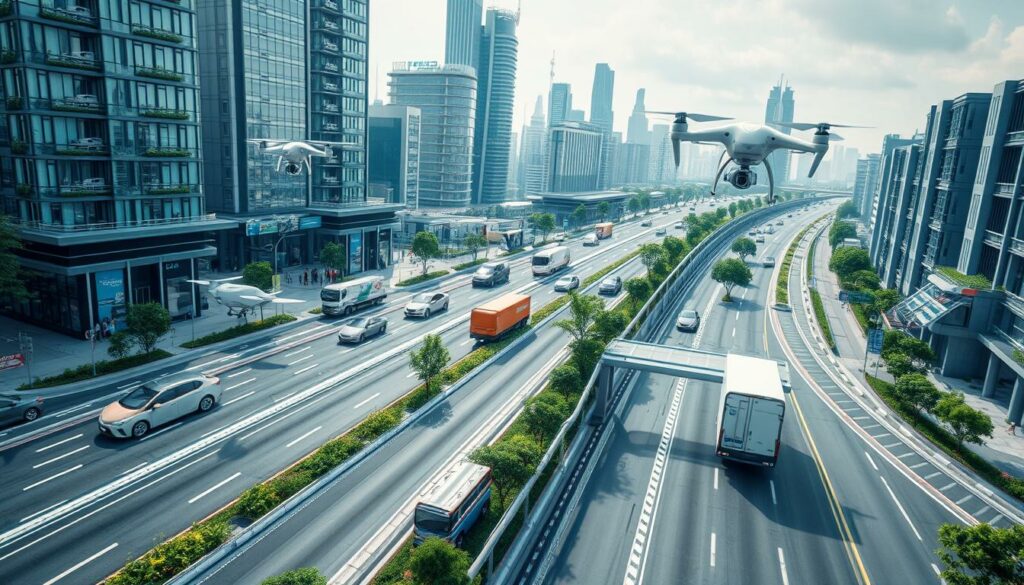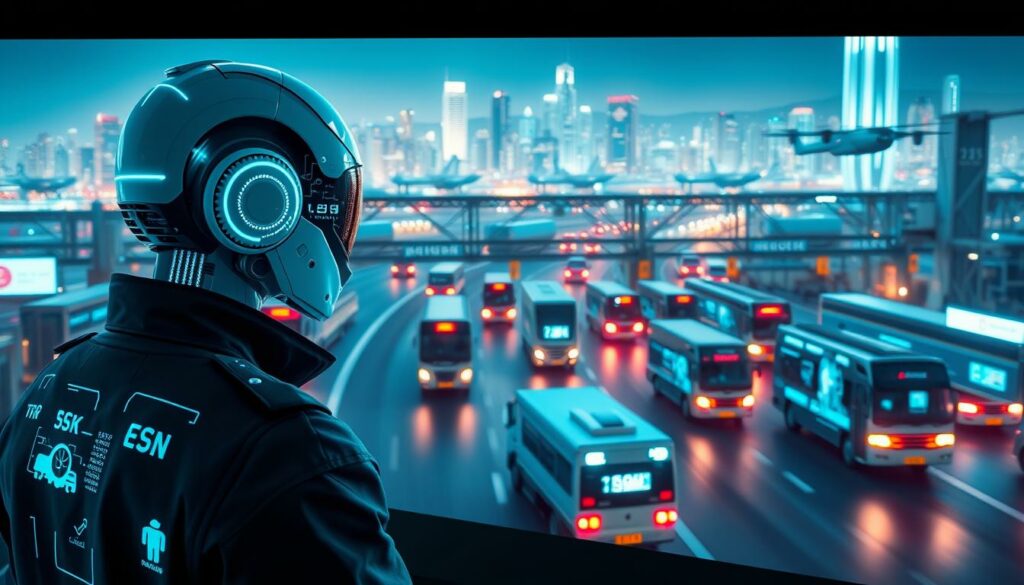E-commerce is booming, leading to higher demands for quick, smart logistics. Artificial intelligence plays a vital role in this shift. It brings costs down and keeps deliveries fast and precise. AI’s role in logistics means smarter warehouses, better route planning, predictive upkeep, and precise demand predictions. This makeover aims for growth and happier customers.
Key Takeaways
- Amazon and Alibaba are pioneers in using AI for logistics.
- Automated warehouses like Amazon’s Kiva system show the value of data annotation.
- Autonomous trucks and drones are being explored to cut transportation expenses.
- Data annotation boosts demand forecasting and better inventory control.
- FedEx employs AI chatbots to raise customer service standards.
The Role of AI in Modern Transportation
AI is changing how we handle fleets, take care of vehicles, and develop self-driving tech. The global automotive AI market was worth $2.99 billion in 2022. It’s expected to grow at a rate of 25.5% from 2023 to 2030. This growth shows how fast AI is being embraced in transportation.
AI-Powered Fleet Management
AI helps the logistics world by making routes better and keeping an eye on vehicle health. This cuts down on fuel use and speeds up deliveries, boosting how well things run. Thanks to real-time data, fleet managers can make smarter choices. This leads to less pollution and better fuel use.
Predictive Maintenance Solutions
Predictive maintenance stops vehicles from breaking down unexpectedly and lowers repair costs. AI forecasts when vehicles need care, making it easier to keep them in good shape. It analyses sensor data to find issues and alerts owners, keeping vehicles safe and reliable.
Autonomous Vehicle Development
Creating self-driving cars is a key use of AI in transportation. Companies like Waymo test autonomous trucks and minivans in the US. This tech aims to cut down on human mistakes, which cause many road accidents, and make traffic smoother. Self-driving cars promise a future with less congestion and safer roads.
Smart Transportation Technology Transforming Logistics
The world of logistics is changing fast, thanks to smart transport tech. This tech plays a key role in providing valuable data that leads to smart decisions and better efficiency.

Among these innovations, real-time tracking and monitoring stand out. They offer a clear view of goods throughout their journey. This way, managers can quickly tackle any issues. Keeping an eye on where vehicles and goods are at all times helps adapt plans fast, reducing wait times and keeping goods safe.
Real-Time Tracking and Monitoring
Real-time monitoring is changing logistics for the better. Using GPS, we can now track vehicles accurately. This helps choose the best paths, reduce fuel use, and get deliveries done quicker. For example, GPS in public transit has cut down on waiting and made travel more predictable.
Automated fare systems make public transport easier too, with contactless payments and mobile tickets. These changes mean faster boarding and fewer lines. The logistics world gains a lot from these systems by getting better at what they do and making smarter choices.
Intelligent Route Optimization
Smart route planning uses AI to look at traffic, weather, and how vehicles are running. By doing this, it finds the quickest ways to get from A to B. AI in traffic management means less jamming up, by guessing where traffic will be and adjusting signals right away.
Companies like Moovex have cut transport costs by finding smarter routes. AI has also helped big logistics networks like UPS. They save fuel and speed up deliveries by planning better routes.
Platforms such as Fabric are changing eCommerce with a focus on doing things sustainably and efficiently. Smart route planning means they can work better and make more money.
New tech in smart transportation and route planning is making logistics more reliable. It’s helping meet today’s supply chain needs by making transport more efficient.
Implementing AI Agent for Transportation in Supply Chains
Today, using AI agents in transportation supply chains is key. They help make operations smoother and cut down costs. A study by McKinsey showed a 15% cut in logistics costs. Plus, inventory levels improved by 35%.
Automated Warehouse Operations
Robots and AI make warehouse operations way better. They help with storage, sorting, and picking. This makes orders go out faster and reduces mistakes. UPS’s system, ORION, saves on fuel and lowers miles driven. This boosts productivity and accuracy for on-time deliveries.
AI-Driven Inventory Management
AI makes managing inventory smarter. It predicts what customers will want and keeps the right amount of stock with real-time data. Avoiding running out of items and cutting down on holding costs. A study found that 82% of logistics companies say AI will be key in the next three years. Using AI for inventory management makes businesses use resources better and keeps customers happy.
Check out Solulab’s article for more on AI in logistics and supply chains.
Case Studies: Success Stories of AI in Transportation
The transportation and logistics sector has greatly benefited from AI. Remarkable advancements have led to improved operational efficiency and customer satisfaction. FedEx and Amazon are prime examples of these success stories.
FedEx’s AI-Driven Customer Service
FedEx has used AI to better its customer service. They employ FedEx AI in various ways, like AI chatbots. These chatbots provide round-the-clock support and offer quick, accurate tracking info. This effort has made customers happier by giving them the updates they need fast.
Amazon’s Automated Warehouses
Amazon’s supply chain has been transformed by Amazon automated warehouses. By using Kiva robots, Amazon automated many tasks in their warehouses. This change has sped up how fast they process orders and lessened their need for manual labor. Their operations became more efficient and effective as a result.
| Company | AI Application | Key Benefits |
|---|---|---|
| FedEx | AI-Driven Customer Service | Improved Customer Satisfaction, Quick Information Access |
| Amazon | Automated Warehouses | Faster Order Processing, Reduced Manual Labor |
AI has changed the game in transportation and logistics. By 2026, the market for AI in this sector is expected to hit $3.87 billion. Also, AI platforms are making ticketing better, not just faster. They offer personal experiences and make routes and schedules more efficient.
Benefits of Machine Learning in Transportation
Machine learning in transportation offers transformative benefits for logistics and transit systems.
It enhances decision-making. By using AI, it analyzes data from traffic cameras and sensors to optimize routes. This improves traffic flow and reduces congestion. AI also offers personalized guidance based on traffic and driver preferences.
AI contributes significantly to safety. It monitors traffic with AI-powered cameras to spot and alert dangerous situations fast. By studying accident data, it can predict high-risk areas on the roads. This proactive approach reduces accidents and boosts commuter safety.
Operational efficiency is another key benefit. AI predicts when road repairs are needed, ensuring timely maintenance. This approach prevents unexpected road issues, extending infrastructure lifecycles.
Cost reduction is a major outcome. Machine learning streamlines operations, cutting fuel use, labor costs, and vehicle wear. This results in huge savings for transportation providers, making them more competitive globally.
Machine learning also helps fill data gaps, like road characteristics, by analyzing aerial images. This aids planners in improving road safety.
In service delivery, AI allows real-time adjustments to transit schedules and routes, ensuring reliability. For example, it adapts to accidents or road closures to minimize passenger disruptions.
| Benefits | Details |
|---|---|
| Enhanced Safety | AI algorithms monitor traffic, predict high-risk areas, and alert authorities to dangerous situations. |
| Improved Decision-Making | Data analysis optimizes routes, traffic flow, and maintenance schedules. |
| Operational Efficiency | Predictive maintenance reduces unexpected road failures and extends infrastructure lifecycles. |
| Cost Reduction | Streamlined operations lead to reduced fuel consumption, labor costs, and vehicle wear and tear. |
| Effective Service Delivery | Real-time adjustments to transit schedules and routes improve reliability. |
| Data Gap Filling | Analysis of aerial images provides crucial data for transportation planning. |
Machine learning in transportation is a pivotal innovation. It tackles current challenges while setting the stage for a safer, more efficient, future in logistics and transit.
Challenges and Considerations in Deploying AI
Deploying AI in transportation can change things for the better. However, we must tackle a few big challenges for the best results. One main issue is the quality of data and how it’s labeled, which is crucial for AI to work right. Also, there are strict rules and laws on using AI in transportation that we need to follow carefully.
Data Annotation and Quality
For AI in transportation to succeed, we need top-notch data. Data annotation in AI means labeling data correctly. This is key for training machine learning models that are reliable. Companies have a tough job managing and accurately labeling huge amounts of data. This takes a lot of time and money. For example, when AI checks for defects better and faster than humans, it shows how important good data annotation is.

AI systems use different methods to handle data, like supervised or unsupervised learning. As data gets more complex, keeping its quality high becomes harder. We need better tools for labeling data to avoid errors or bias. Making sure the data labeling is done right is very important.
Regulatory and Legal Frameworks
AI in transportation has to meet many legal and rule-based requirements. This can be tough. Regulatory challenges in AI deployment include protecting data privacy, meeting safety standards, and thinking about ethics. For example, self-driving cars must pass strict safety tests to be trusted. Understanding these rules well is a must for companies.
The AI for Intelligent Transportation Systems (ITS) report talks about data privacy, security, and fairness as big concerns. Not having clear rules for data sharing makes things more complicated. Companies should test small before going big and use what’s already there to help tackle these problems. Solving these legal and rule-based challenges is key to using AI in transportation the right way.
Future Trends in Autonomous Transportation AI
The future of transportation is changing because of AI. Autonomous vehicles use advanced AI to process data like images and radar info. They use cameras and GPS to make safe and accurate travels.
Explainable AI (XAI) is becoming popular. It makes AI in cars clearer and focuses on users. This leads to safer, more personalized driving thanks to voice recognition and more.
AI in car cockpits is also getting better. We need powerful AI systems for future transportation. NVIDIA’s DRIVE IX is an example that helps modern cockpits meet these needs efficiently.
AI is transforming how we drive and manage traffic. It makes traffic smoother in cities by analyzing data quickly. These systems make fast decisions to improve transportation.
But, deploying AI in transportation is not easy. It costs a lot at the start and needs the right setup for updates. Developing countries could benefit by adding AI to buses gradually, saving money.
AI can also make travel better for everyone. It helps create systems that everyone can use, even those with disabilities. This could mean helping blind people get around with voice updates and more.
- Deep-learning models: Key to processing diverse data types
- Explainable AI (XAI): Ensuring transparency and user-centric design
- Biometric authentication: Personalizing driving experiences
- NVIDIA DRIVE IX: Aiding in future cockpit necessity
- AI-powered data analysis: Enhancing traffic flow and efficiency
- Modular AI systems: Reducing implementation costs in developing nations
- Inclusive AI solutions: Improving navigation for disabled citizens
| Future Trends | Description | Impact |
|---|---|---|
| AI Cockpits | High-performance and energy-efficient AI platforms | Improved safety and customization |
| Explainable AI | Promotes transparency and human-centered design | Enhanced user experience |
| Personalized AI Features | Biometric user authentication and voice recognition | Personalized and safer driving experiences |
| AI-Powered Traffic Management | Data analysis to improve traffic flow | Increased efficiency in busy cities |
| Inclusive AI Solutions | Accessible systems for disabled citizens | Enhanced mobility and navigation |
Want to know more about AI in transportation? Find more case studies here.
Conclusion
AI agents are changing the game in logistics and transportation. They make things better by improving efficiency, cutting costs, and making things safer and greener. By using AI for things like fleet management and maintenance, companies can make smarter choices.
These advanced technologies are proving their worth. They’re changing logistics through things like better demand forecasting and smarter warehouse operations. For example, robots and AGVs are making the packing process faster, with less need for people.
As transportation keeps evolving, AI will play a bigger role. It helps companies adapt to changes fast and improves customer support with chatbots. In the end, AI will lead to newer, smarter solutions in transportation, pushing the industry forward.
FAQ
What is an AI agent for transportation?
An AI agent for transportation uses artificial intelligence to make transport tasks better. It handles planning routes, checks vehicle health, and supports self-driving. These agents help make things run smoother, keep things safe, and make customers happy.
How is artificial intelligence used in route optimization?
AI looks at loads of data like how traffic moves, weather, and how cars are running. It finds the best paths to take. This smart planning cuts down time and saves fuel, making deliveries more efficient.
What are the benefits of predictive maintenance in transportation?
Predictive maintenance uses AI to keep an eye on vehicles and spot issues early. This stops unexpected problems, cuts down on repair costs, and keeps fleets moving smoothly.
How does AI technology enhance logistics operations?
AI boosts logistics by managing warehouses with robots, forecasting demands, tracking shipments in real time, and planning efficient routes. All these make logistics faster, more precise, and cheaper.
What role do automated warehouse operations play in modern logistics?
Robotic and AI-driven warehouses make storing, sorting, and picking faster. This speeds up getting orders to customers, lowers mistakes, and improves how logistics work overall.
How does AI-driven inventory management optimize supply chains?
AI in inventory management uses up-to-the-minute data to guess what will be needed and keeps just the right stock on hand. This makes managing resources better, lowers costs, and makes supply chains more nimble.
Can you provide examples of companies successfully using AI in transportation?
Big names like FedEx and Amazon are winning with AI. FedEx has AI for talking to customers, while Amazon uses robots to move items around. This makes their operations smoother and faster.
What are the challenges in deploying AI in transportation?
The big hurdles are making sure the data AI uses is good, dealing with laws, and earning trust. This is extra important in self-driving where safety matters most.
What future trends are anticipated in the development of autonomous transportation AI?
We expect more AI self-driving cars being made and used. AI will also get better at making logistics and supply chains work faster and smarter.
How does machine learning improve transportation efficiency and safety?
Machine learning figures out from a lot of data how to pick the best routes, see maintenance coming up, and make travel safer. It helps make better decisions, work better, and keep up with global competition.



